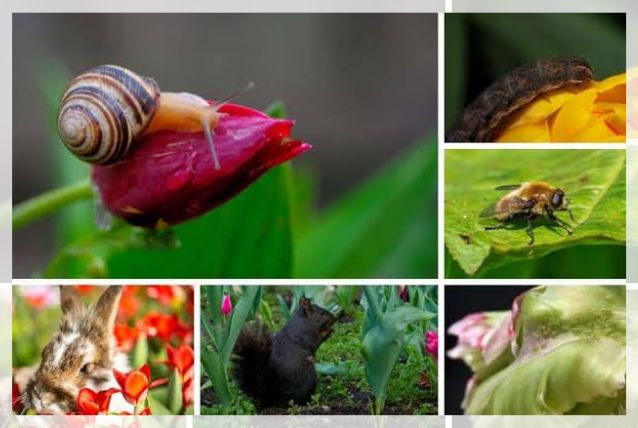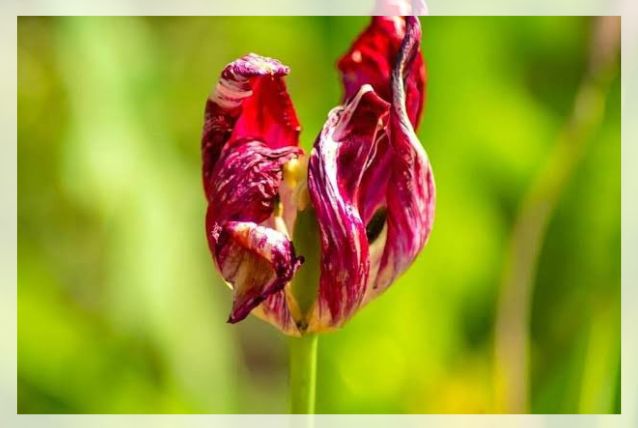Garden tulip flowers make a great addition to your yard.
Just like daffodils add color to your yard, garden tulip flowers will add color to your garden and yard.
Tulips are among the most cultivated plants and you can see hybrid forms in just about every color except for true blue.
Moreover, these plants have two to six broad, strappy leaves with a waxy coat that gives them a blue-green color.
It is important to note that most plants will have one flower per set, however, a few of them are multi-flowering.
There are thousands of types of tulips that spread over 15 official classifications depending on flower shape, height, and time of bloom.
Furthermore, the flowers are often cup-shaped, with three petals and three sepals, but with these general descriptions, there is a wide variety.
It includes types with ruffles, fringes, and fully double blossoms that look like peonies than tulips.
Keep on reading.
Garden Tulip Flowers
In a lot of regions, you can plant tulip flowers in the fall when they receive the winter chill that needs to bloom in the spring.
Once they emerge from the ground, these plants grow and flower quickly.
In cold winter climates, they often emerge in March and begin to flower in April to May.
Though these plants are perennial bulbs, many hybrid types tend to be short-lived.

Moreover, if you want to keep a huge display of tulips, you will need to plant additional bulbs each fall for the following spring’s showcase.
Like other plants of the same family, Liliaceae, i.e. lily family, tulip bulbs contain alkaloid and glycoside compounds.
These are mildly toxic to humans, however, seriously toxic to pests.
Along with leading to gastrointestinal symptoms, if you consume the bulbs, tulip bulbs can cause a skin rash: tulip fingers when you handle them.
Quick Facts about Garden Tulip Flowers
Some quick facts about garden tulip flowers are:
| Common Name | Tulip |
| Botanical Name | Tulipa spp. |
| Family | Liliaceae |
| Plant Type | Perennial, bulb |
| Mature Size | 9–24 in. tall, 6–9 in. wide |
| Sun Exposure | Full |
| Soil Type | Rich, well-drained soil |
| Soil pH | Acidic, neutral |
| Bloom Time | Spring |
| Flower Color | Red, Pink, Orange, Yellow, Green, Purple, Black, White |
| Hardiness Zones | 3–8 (USDA) |
| Native Area | Europe, Asia |
| Toxicity | Toxic to humans, toxic to pets |
Learn more about Poisonous Plants for Pets here.
Garden Tulip Flower Care
It is important to note that tulips tend to grow best as perennials in climates with moist, cool-to-cold winters and warm, dry summers.
You will need to plant the bulbs 4 to 8 inches deep in the fall, which is a depth of about three times the size of the bulbs.
Make sure that the spot receives sunlight and is well-draining soil.
As they sprout and bloom early in the spring, tulips can work well beneath trees and shrubs that tend to leaf out to create shady conditions later in the space.
Moreover, you should sprout the bulbs 2 to 5 inches apart depending on the size, with the pointy end facing up.
These plants tend to display best if you plant them in groups of about 10 bulbs.
In some cases, you can also grow as annuals, especially the hybrid varieties.
In such cases, you will need to dig up and discard the bulbs after they bloom, then plant summer flowers in their place.
Tulips are quite easy to grow if you live in cool/cold winter seasons.
However, hybrid types will need to be divided every few years to keep them from declining.
Light and Soil Requirments
It is important to note that all varieties of tulip flowers tend to thrive best in full sun.
Though the areas under deciduous trees that are shady in summer are mostly sunny in the early spring when your plant is actively growing.
Therefore, these spaces can be excellent spaces to grow tulips and other spring bulbs.
Moreover, these plants prefer rich, well-draining soil with a pH that tends to be neutral to slightly acidic i.e. 6.0 to 7.0.

To improve drainage, you can mix compost and provide nutrients to the bulbs.
In ideal cases, you should do this before planting the bulbs.
Or you can apply a few inches of compost over the soil to encourage earthworms to tunnel into the soil.
This will help improve circulation and tilth.
Water, Temperature, and Other Requirments
Make sure to water your bulbs thoroughly after you plant them.
However, stop watering them after this except during extended dry spells.
If your region gets some rain every week or so, avoid watering your tulips at all.
In arid regions, you should water them every two weeks, according to experts.
Garden tulip flowers tend to thrive in regions that are cool-to-cold in winter and are dry, and warm during summer.
These conditions are found through much of the USDA zones of 3 to 8.
They will need 12 to 14 weeks of temperatures below 55 degrees Fahrenheit in order to bloom, so in regions with warm winter temperatures, you will need to plant them as annuals from supplies that prechill the bulbs.
These plants tend to do well in dry regions rather than humid climates as high humidity often goes hand-in-hand with lots of spring and summer rain.
This can cause the bulbs to rot.
Furthermore, you will need to add compost, bone meal, or granular fertilizer to the planting hole when you plant them.
For the amount to use, always follow the instructions on the product label.
Feed them again in the coming spring, when they sprout again.
Apart from this, you do not need to feed them.
Types of Garden Tulip Flowers
There are a lot of varieties of garden tulip flowers that can be bewildering as there are 15 separate divisions.
These depend on characteristics like plant size, bloom time, flower shape, and genetic origin.
Let’s discuss them as follows:
Single Early: These are cup-shaped flowers with one flower per short term, first tulips to bloom that start in later march.
Double Early: These have more than the usual number of petals.
They have a fluffy appearance, have tall stems of about 12 to 15 inches, and begin blooming in early April.
However, they can be damaged due to cold snaps and winds.
Triumph: This one is a cross between early and late singles.
Moreover, they have tall stems of about 15 to 18 inches and are late-April bloomers.
Darwin Hybrid: This one is a cross between Darwin and Fosteriana.
They have tall stems of about 24 inches, are very hard, naturalize well, and bloom in later seasons into May.
Single: One bloom per stem, popular for its wide range of colors, and late-season bloomers.
Lily-Flowered: These are tall about 18 to 24 inches, and are late-season bloomers with pointed, slightly flared petals.
Fringed: Fringed or ruffled petal edges that come in a lot of colors.
In some cases, they may also have contrasting colors on the fringes.
Moreover, these are late-season bloomers that have 12 to 18-inch stems.
Viridiflora: These are late-season blooms with 12 to 24-inch stems.
They have distinctive green streaks in their petals.
Rembrandt: These were once popular for their colorful streaks and mottling.
However, they are no longer grown commercially as the coloring was caused by a virus that spreads to other tulips.

These are now advertised as ‘Rembrand’ and are cultivators that mimic the look of the originals.
Parrot: They got their names from their buds that resemble the parrot’s beak.
Its flowers are large, with twisted, curling petals on the tall stems of about 12 to 24 inches, and are late-season blooms.
Double Late: Also known as peony tulips have tall stems of about 18 to 24 inches, with enough petals to rival peony bloom.
However, these are not hardy. But they will thrive well in containers.
Kaufmannian: These are also known as water lily tulips.
Moreover, this cultivator is an early bloom with wide-open flowers, that are almost flat.
Its leaves tend to have brownish-purple mottling and are short plants with only 6 to 12 inches tall stems.
Fosterinana: These are also known as emperor tulips.
They have large flowers, have pointed petals, and you can find them in a number of colors.
Moreover, they bloom mid-season while the plant is 8 to 15 inches tall.
Species or Wild Tulips: These are great or perennializing, are short plants with 4 to 12 inches stems, have a number of varieties, and have varying bloom times.
Popular Cultivators
There are thousands of named cultivators across the tulip division, however, a handful of popular ones are:
Purissima comes from the Fosterinana division, is very early, have pale yellow petals that tend to fade to white.
Ballarina comes from the lily division and is fragrant with flared, pointed, orange petals.
Ballarina, this one that comes fosteriana division, are sunny yellow with white tips that look like feathers.
Prinses Irene comes from the Triumph Division and has Rambrandt-style orange petals with streaks of burgundy.
Spring Green comes from the Viridiflora division.
Moreover, these cultivators have white petals with green center stripes that are late-blooming and long-lasting.
Las Palmas comes from Fringed Division and has large, fringed petals with a red flame.
These are long-lasting cut flowers.
Vanilla Coupe comes from Double late division, are yellow, have double five-inch blooms with an outer layer of green petals, and bloom in late May.
Diamond Jubilee comes from the Triumph division and is a mid-spring bloomer with creamy white petals edged in vivid pink.
Pruning and Propagating Tips
When you grow garden tulip flowers are perennials, you will need to remove the flower stalks as soon as they flower to prevent the plant from producing seed pods.
This is because they can drain the energy of the bulb and shorten its life.
Leave the foliage in place until it turns yellow in mid to late summer.
This will help to replenish the energy of the bulb.
While you can propagate tulips from seeds, the most common way is to lift the bulbs and divide the offset bulbs or bulblets that are with the mother bulb.
You should do this in the fall, at the normal planting time for tulips.
To do this, follow the steps below:
- dig the bulbs with a trowel or spade and brush off the soil
- gently break off the small offset bulbs from the mother bulb
- make sure to inspect the offsets and discard any that may be sot or deformed
- replant the offsets and the mother bulbs at the depth of about three times the diameter of the bulb
- make sure that the pointed side is facing up
For the first few years, the new tulips may produce foliage, however, no flowers.
After about the third year, you can expect new bulbs to bloom.
Growing Tulips from Seeds
Propagating tulips by seeds is not uncommon, as they are slow-growing plants, and seeds you collect from hybrid plants often do not “come true” to the original plant.
Species tulips, however, will come true if you plant the seeds in the pods that are left after the flowers fade.
But nursing the seeds through germination to mature plants with bulbous roots is a very slow process, and requires about 2 years or so.
After you collect the seeds from the dried pods, you can store them in the refrigerator for at least 12 to 14 weeks.
Then you can sow them on the surface of small pots and fill them with potting mix.
In cold winter areas, you can plant tulip seeds indoors in late February.
Moreover, cover the seeds with a bare covering of additional potting mix or 1/4 inch.
Place the pot in a sunny spot and keep them moist until the seeds sprout.

You can then move the pot outside once the weather warms, keeping the seedlings growing in the pot through the spring, summer, and fall.
Feed them weekly with a half-strength dose of a balanced fertilizer, 10-10-10.
This heavy feeding is important for the seedlings to create bulbous roots.
During late fall, you will need to move the potted plants back into the refrigerator, or into the cold frame for outdoor chilling.
Again you will need to chill your plants for at least 12 weeks.
In later winter, or early spring after the chilling period is complete, bring the pots outdoors to sprout and grow once more.
Once it fully develops in this second growing season, you can transplant garden tulip flowers to permanent garden locations.
However, the key is to remain patient, as it can take another full year before seed-started plants are ready to flower.
Potting, Repotting and Overwintering your Plants
It is easy to grow tulips in well-draining pits that you fill with standard potting mix.
This is the most common method you can use if you want to force tulips into midwinter bloom indoors.
However, timing is crucial as the bulbs will need a 12 to 14-hour chilling time.
Plant these chilled bulbs about 2 to 3 inches deep, lightly moisten the soil, and store the pots in a dry, cool location of about 35 to 55 degrees Fahrenheit.
Or you can plant them outdoors in a shady location if you live in a cold winter climate.
After the chill period is over, bring the pots into a bright room at moderately warm temperatures of about 60 to 65 dress F.
Within 3 to 5 weeks, your plant will flower.
Therefore, for late January or early February bloom, you will need to plant your bulbs in late September and chill them until late December.
When you are growing them in cold winter zones, garden tulip flowers will need no special winter protection.
However, experts advise that it is best to withhold watering in fall as wet winter soil can encourage bulb rot.
Moreover, fall tends to be a good time to divide bulbs, which experts recommend every 3 to 5 years for hybrid varieties.
Common Pests and Plant Diseases
It is important to note that garden tulip flowers, bulbs, and foliage tend to be popular with a lot of animals like deer, squirrels, and other rodents.
In some areas, it is not even worth plating them in the ground and you are better off growing them in containers.
On the other hand, you can also try deterrents or interplant these plants with daffodils, but make sure to lose a few.
Insect pests that can affect tulips are:
Aphids: You can wash them off with water spray or squash them with your fingers.
Bulb mites: In some cases, you can find them in bulbs that you purchase from the market.
Make sure to inspect the bulb for signs of decay. A brief two-minute soak in 120-degree water will kill them.
Thrips: You can fight them with the help of sticky traps or by introducing ladybugs and green lacewings as predatory insects.
Moreover, you can notice thrip damage as brown or silvery streaks on the leaves of the tulip.

Tulips are susceptible to basal rot and fire fungus.
Basal rot tends to appear as dark brown spots or as pink or white fungus on the bulbs.
Plants that grow from the affected bulbs can be deformed and/or die early while the best remedy is to discard the affected bulb and plant new bulbs that have been treated with a fungicide.
On the other hand, when fire fungi affect the bulbs, they tend to be malformed or stunted plants or plants that never emerge.
Affected plants can have curling shoots or dead areas with dark green rings.
You can treat the affected plants with a fungicide, discard the affected bulbs, and plants new bulbs that you treat with a fungicide.
How to get Tulips to Bloom?
When your plant is mature, it will normally bloom reliably in spring if the conditions of right.
These include plenty of sun, and fertile, well-drained soil.
However, when they fail to bloom, it is often one of the following reasons:
The Bulbs are not mature enough. This happens particularly after dividing, small bulbs tend to take a year or two to develop into flowering plants.
With the help of good spring feeding, you can help speed up their development.
The Bulbs are too Old, In particular, hybrids are fairly short-lived, and when they begin to decline, you will need to dig them up.
Then split off the younger offset bulbs and replant them.
Your Plant is not getting enough Sunlight. Tulips tend to be sun-loving plants, so make sure to avoid placing them where fences, walls, or coniferous trees case shade them.
The Bulbs need Feeding: Though tulips are not heavy feeders, you still need to give them a healthy dose of bulb fertilizer when planting and each spring thereafter.
Common Plant Problmes
When you provide garden tulip flowers with the right location and climate, they are trouble-free, though some hybrid types can decline much faster than you would want them to within three to four years.
There are, however, some common complaints:
Tall Varieties Flop Over In some cases, hybrid tulips that have large blossoms and flower stalks that are 2 feet or more in height may flop over.
Such types will need staking, especially when the plant is in semi-shade spots that encourage legginess.
Plant Collapse at Ground Level: When the plant stem grows soft and collapses at ground level, it is mostly due to root or stem rot that occurs due to excessively moist soil.

Moreover, make sure to remember that tulips are native to moderately dry conditions in Europe, and Aia.
They tend to thrive well in conditions that mimic that environment.
Foliage is Twisted, Distorted: This is often a symptom of a serious fungal disease and will need you to dig up and destroy the bulb before it spreads to other plants.
Flowers and Flowers Buds are Streaked, Distorted: This often occurs as a symptom of the tulip virus which has no cure.
You will need to remove and discard affected plants. Make sure to not compost such plants as it will allow the virus to transmit.






Leave a Reply